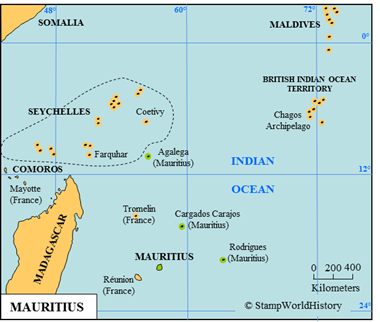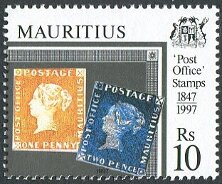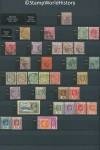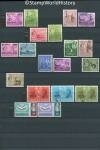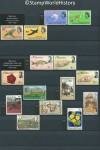
Mauritius
British possession
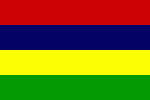
Mauritius
Independent state
Quick reference
General issues: British colony 1847-1967, British colony, self government 1967-1968, Independent within British Commonwealth 1968-1992, Republic 1992-Present
Country name on general issues: Mauritius
Currency: 1 Shilling = 12 Pence 1847-1878, 1 Rupee = 100 Cents 1878-Present
Population: 375 000 in 1900, 1 261 000 in 2014
Political history Mauritius
First a French colony
Mauritius is located in the Indian Ocean east of Madagascar. The island of Mauritius is of volcanic origin and prior to the arrival of Europeans uninhabited. The first Europeans to discover the island are the Portuguese in the early 16th century. Being settled shortly by the Dutch in the 17th century, Mauritius in the 18th century is claimed and settled by the French, becoming a French colony. The importance of the island, at the time, is largely due to its strategic location on the shipping routes to India and beyond. An importance that will be greatly reduced after the opening of the Suez Canal in 1867. The French successfully introduce sugar cane as a cash crop. To develop the plantations, slaves are brought to Mauritius from Africa and Madagascar.
British rule and independence
During the Napoleonic Wars, the British capture Mauritius in 1810 as well as other French possessions in the Indian Ocean such as Réunion and the Seychelles. In 1814, Réunion is returned to the French while Mauritius and the Seychelles remain British colonies. The British, in 1839, abolish slavery and subsequently bring laborers from India to Mauritius. Currently, the largest population group on Mauritius are still the Indo-Mauritians, the second largest group being creole – a population group of mixed ethnic origins.
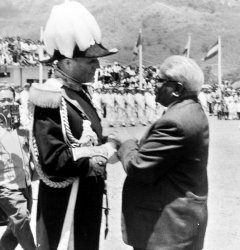
1968 – The British governor and the Mauritian prime minister on Independence Day.
From the 1940’s, Mauritius has been moving towards independence. Finally self government is attained in 1967 and independence in 1968 – Mauritius becoming an independent state within the British Commonwealth. In 1992, Mauritius is proclaimed a republic – though remaining a member of the British Commonwealth. Politically, Mauritius has been a stable democratic country since independence. Economically, Mauritius has successfully diversified from the sugar cane production to industry, services – financial services – and tourism.
The island and the country of Mauritius
From Mauritius several other British possessions have been administered. Thus, the Seychelles, until made a separate colony in 1903 – Coetivy Island and the Farquhar Atoll being transferred from Mauritius to the Seychelles in 1908 and 1920 respectively. The Chagos Archipelago was part of Mauritius until transferred to the British Indian Ocean Territory in 1965 – a territory newly formed in the process of British possessions gaining independence to secure the British – and United States – military interests in the region.
The Chagos Archipelago is, until today, claimed by Mauritius, as well as the current French island of Tromelin. The country of Mauritius, as we know it today, exists of the islands of Mauritius, Rodrigues and Agalega and the shoals of Cardagos Carajos. Rodrigues and Agalega have small permanent populations, Caradagos Carajos has a transient population of fishermen.
Postal history Mauritius
The first stamps used on Mauritius are stamps of Great Britian. The first stamps issued for Mauritius date from 1847 – designed and printed locally. While the first issues are of local design and print, later issues are printed in Great Britain and largely show designs common to the British colonies. The stamps of Mauritius have been used on the Seychelles until 1890 when the Seychelles started to issue their own stamps. Since independence, the issues of Mauritius have been a blend of themes of national interest and themes of interest for the thematic collectors market. For an informative much more detailed insight in the stamps issued in the classical era, please refer to the Mauritius page on Big Blue 1840-1940.
The early issues of Mauritius are all in the high catalog value category. Most famous, of course, is the ‘Blue Mauritius’, followed closely by the ‘Orange Mauritius’, both issued in 1847. Stamps that rank among the most expensive stamps in the world – currently, in auction value surpassed only by the Swedish ‘Treskilling Yellow’ and the British Guyana ‘Black on Magenta’.
Album pages
← Previous page: MauritaniaNext page: Mayotte →

